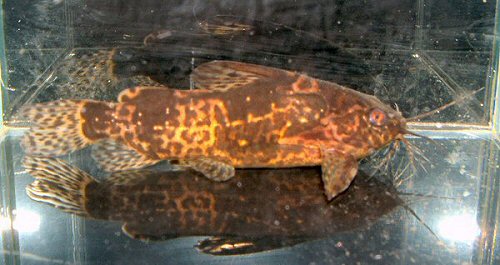SCOTCAT.COM
your internet guide to all things catfish
| An African Catfish (Mocholkiella paynei) |
by Steve Pritchard |
During the late 1970's early 1980's I frequently visited the Natural History museum in South Kensington, initially to attend an evening class in ichthyology, and then to do some simple research into the, African catfish genus Synodontis, of which there are many different specimens in the fish collection.
Mocholkiella paynei
This was a fantastic, if somewhat macabre way to spend your spare time. Rows and rows of jars full of type specimens, (the original fish from which a species has been described), ranging from the Corydoras paleatus brought back by Darwin on the Beagle, to species yet to be described. Early summer 1980 I had seen a new catfish in some of the shops. It looked like a Synodontis, but was it? I brought some and had the opportunity to take a recently dead specimen. The course at the museum had taught me that the skeleton could help with identification. The body was laid in some fresh water outside and nature did its work. Within a couple of weeks the hard bony plates of the skeleton became visible. This method, although primitive and not exactly scientific, was effective in this case. (I do not think you would see the skeleton of a tetra in this way). Looking through my reference books, this 'Synodontis' didn't match any of those covered, so off to the museum's collection to see if I could find it. Gordon Howes was busy in the office, so I had free reign to look through the collection for my fish, jar after jar, shelf after shelf, rack after rack. No luck, time for coffee. Gordon invited me to see what he had been working on, a new catfish. Not a Synodontis, but a new genus, Mocholkiella. I looked closely at the specimens.. My Catfish! Gordon was just completing the description. He had received three specimens from Dr. Ian Payne in I970. After research in other collections, to try to establish the identity of the specimens, the description was published in 1980. In identifying the specimens as the fish had at home, we arranged that Gordon could come and see for himself the living fish, and an extra bonus, the skeletal remains I had been cleaning. Further investigation with the retailer identified the importer as Queensborough Fisheries at Wraysbury. A trip to Wraysbury confirmed that the import came from Sierra Leone, and gave Gordon more specimens to view. As Gordon said
in this article for the Catfish Association of Great
Britain, (CAGB), in July 1980, "what a strange
set of coincidences, that after having waited around
in the Museum collections for so many years, this
little catfish should have been 'discovered' by the
aquarium trade. I think this is a rather nice example
of the co-operative effort between ichthyologist and
the aquarist." |
If you would like to contribute an article, please e-mail me. You will of course be credited for your work.
If you would like to donate any denomination of money to the site just click the above link button. All proceeds will go to running the site and hopefully to keep it going for a few years yet.
Print or e-mail this article below


